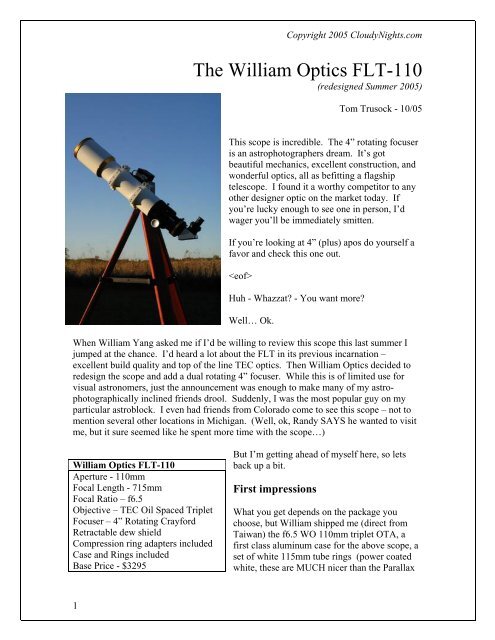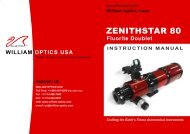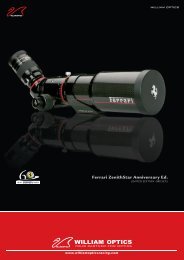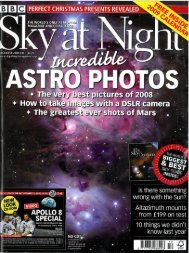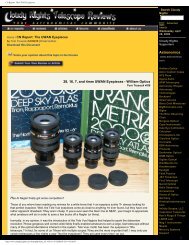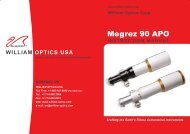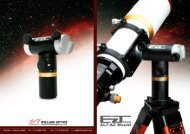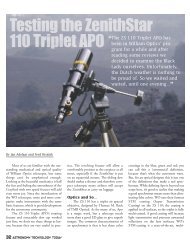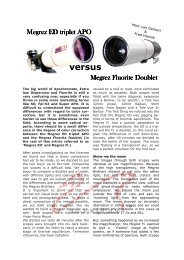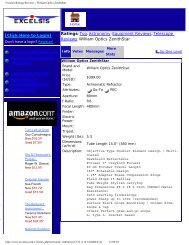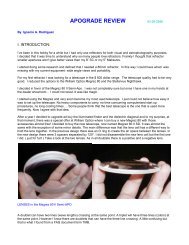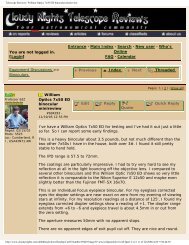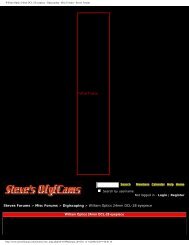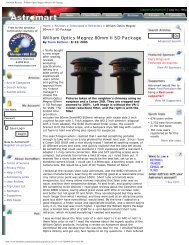William Optics FLT-110 - Cloudy Nights
William Optics FLT-110 - Cloudy Nights
William Optics FLT-110 - Cloudy Nights
- No tags were found...
You also want an ePaper? Increase the reach of your titles
YUMPU automatically turns print PDFs into web optimized ePapers that Google loves.
Copyright 2005 <strong>Cloudy</strong><strong>Nights</strong>.comThe <strong>William</strong> <strong>Optics</strong> <strong>FLT</strong>-<strong>110</strong>(redesigned Summer 2005)Tom Trusock - 10/05This scope is incredible. The 4” rotating focuseris an astrophotographers dream. It’s gotbeautiful mechanics, excellent construction, andwonderful optics, all as befitting a flagshiptelescope. I found it a worthy competitor to anyother designer optic on the market today. Ifyou’re lucky enough to see one in person, I’dwager you’ll be immediately smitten.If you’re looking at 4” (plus) apos do yourself afavor and check this one out.Huh - Whazzat? - You want more?Well… Ok.When <strong>William</strong> Yang asked me if I’d be willing to review this scope this last summer Ijumped at the chance. I’d heard a lot about the <strong>FLT</strong> in its previous incarnation –excellent build quality and top of the line TEC optics. Then <strong>William</strong> <strong>Optics</strong> decided toredesign the scope and add a dual rotating 4” focuser. While this is of limited use forvisual astronomers, just the announcement was enough to make many of my astrophotographicallyinclined friends drool. Suddenly, I was the most popular guy on myparticular astroblock. I even had friends from Colorado come to see this scope – not tomention several other locations in Michigan. (Well, ok, Randy SAYS he wanted to visitme, but it sure seemed like he spent more time with the scope…)<strong>William</strong> <strong>Optics</strong> <strong>FLT</strong>-<strong>110</strong>Aperture - <strong>110</strong>mmFocal Length - 715mmFocal Ratio – f6.5Objective – TEC Oil Spaced TripletFocuser – 4” Rotating CrayfordRetractable dew shieldCompression ring adapters includedCase and Rings includedBase Price - $3295But I’m getting ahead of myself here, so letsback up a bit.First impressionsWhat you get depends on the package youchoose, but <strong>William</strong> shipped me (direct fromTaiwan) the f6.5 WO <strong>110</strong>mm triplet OTA, afirst class aluminum case for the above scope, aset of white 115mm tube rings (power coatedwhite, these are MUCH nicer than the Parallax1
Copyright 2005 <strong>Cloudy</strong><strong>Nights</strong>.comrings I use on my FS102NSV and are a bit more expensive too, but hey), and their top ofthe line quartz diagonal. Finally WO sent an extension tube and .8x reducer/fieldflattener with their big box o’ goodies.Now, I’ve seen, owned and used a fairamount of telescopes of all brands, and Ithought I was somewhat immune – butfrankly, my heart beat a little faster as Iopened the box.Having seen several <strong>William</strong> <strong>Optics</strong>telescopes I was ready for first ratemechanics and a gorgeous presentation. Yet,even so, my first peek took my breath away.WO’s telescopes are gorgeous – and this istheir flagship. Befittingly, it’s a step above.As compared to any other scope I’ve hadopportunity to use – well, the fit and finish isas good as anything I’ve seen.<strong>William</strong> Yang shot high when he built thisone – and it shows. Opening the shippingcontainer, I was shocked to see just small theincluded case is – a mere 28 x 8.9 x 9.1inches I must confess I was expectingsomething more in line with my TV102 orFS102 case. This is significantly shorter and more compact – ergo, much easier to travelwith. It’s only down side is that there is no room for either diagonal or eyepieces.Opening the case, your senses are assaulted with one impressive telescope. The OTA is awhite crinkle finish with black anodizing and gold trim – very similar to that found on theMegrez line of telescopes. The white powder coat is both durable and easy to clean.The giant 4” focuser is anodized black, and impressive as all get out. The sheer size ofthe focuser makes you forget this isn’t an 80mm scope – at least until you pick it up andget it out of the case. I rather expected it to be a beast, weight wise, but surprisingly itturned out to be rather light. At 13.5 lbs, it’s only a little heavier than my other, smaller,4” apos. Mount wise, it tended to ride easier than either the Tak or the TV – undoubtedlydue to its shorter body. The focal length is 715mm, making it an f6.5, and the lens is a<strong>110</strong>mm oil spaced triplet manufactured for WO by TEC.Sliding out the dew shield, we’re treated to a first. It literally pops into place. Someinvestigation (and a letter from <strong>William</strong>) reveals that WO has used recessed spring loadedball bearings to lock the dew shield. You never have to worry about it sagging or slidingdown when the felt gets crushed. If anyone has ever done this before, please let meknow, as I’m completely unaware of it on any other telescope. The lens cap is an allmetal press fit style with the WO logo emblazoned on the front, similar to what’s foundon their other offerings.2
Copyright 2005 <strong>Cloudy</strong><strong>Nights</strong>.comThe focuser also looks like their standardfocuser – but all grown up. The knobs are ahefty 1.8” in diameter, and they are a joy to use.The tension is adjusted by the use of an allenscrew located on the bottom of the focuser.That said, the default factory tension was justabout perfect. There’s no focuser lock, but theredidn’t appear to be a need. At the factory settension, it easily held my heaviest eyepieces andaccessories as well as a buddies ST2000 CCDcamera with no sign of slippage. Focus travelis 93mm, and the drawtube is calibrated –another feature my astrophotographer buddiesraved over. A two speed focuser should beavailable shortly after this article is posted, butwasn’t available at the time of the review.An extended lookWhile the <strong>FLT</strong>-<strong>110</strong> was a little to much for my Gibraltar, it rode quite nicely both on theDM-4 Tom Peters sent in for review (that one’s coming shortly folks), and an LXD75that seems to have somehow wandered into my garage. Giving the OTA a rap on theside, I found that dampening times on both mounts were similar (the DM-4 was slightlybetter) at around ½ to 1 second each. For visual use, this should give you an idea of whatclass of mount works well with this particular scope.While I’m a fan of unity finders, I found that Ididn’t bother with one while using the <strong>FLT</strong>-<strong>110</strong>.When mounted on the LXD75, the fast focalratio of the scope made it fairly easy to find thealignment stars, and I’ve always found the gototo be pretty much dead accurate. When on theDM-4, I found I simply spent lots of timescanning the night sky, and honestly, frequentlyfound I didn’t care if I got to where I was goingor not – this scope was just that much fun to scanwith. If I did get concerned, I just turned on theDSC’s. With a 40mm TV Widefield the <strong>110</strong>yielded nearly a 4 deg true FOV. This wasenough to frame the Veil perfectly – and agorgeous sight it made from dark skies. At theGLSG, I setup next to a buddy with a 20”Obsession and we pointed these two at the veil.Both views were equally amazing – abet in different ways. Few scopes are capable ofdelivering larger TFOV’s at this aperture.3
Copyright 2005 <strong>Cloudy</strong><strong>Nights</strong>.comComparison to the TV102 and FS102NSV was natural. I found there was a very slightbut noticeable gain over a 4” telescope in light gathering ability – but for most targets thedifference was not readily apparent. I typically found the color correction to be slightlysuperior in the <strong>FLT</strong>, and contrast and resolution were on a par.Visually, the opticsare impressive. Thescope yields a wide,flat, well correctedfield – the onlyaberrations I notedhad nothing to dowith the telescope.Only noticeable atlow power, they weredue to the excessivesize of the exit pupiland the defectsinherent in my owneyes (or in theeyepiece). In terms ofsecondary spectrum (falsecolor) – visually - thereCourtesy <strong>William</strong> <strong>Optics</strong>was a negligible amount. The critical test in the summer / early fall is Vega. Not much isworse (excepting Venus). The very first night I turned the scope toward Vega, I sawnothing but the pure blue white of the star. Turning the scope on the Double Doubleyielded a clean split at only 73x, with the diffraction rings running unbroken around eachairy disk. Picking a random semi-bright star, I defocused and found the fresnel patternsto be remarkably similar both in and out of focus, and the optic had an excellent snap tofocus. The zone of confusion was for practical purposes non-existent. I didn’t have anopportunity to take this scope through much of a temperature change, so I can’t say howthe cell and optic handled extended cool downs but for the minor deltas I was dealingwith (10 deg) there were absolutely no issues.The scope was well baffled (knife edged) and delivered images that were extremelycontrasty with very little scatter. Stars were pinpoints across the field. Although it’s amere <strong>110</strong>mm this refractor treated me to the hands down best full face view I’ve ever hadof M33. Both its spiral arms and largest HII region (NGC 604) were obvious in that slapyou in the face sort of way.Luna is a prime target for a 4-5 inch telescope – especially one with choice optics – andone too often ignored. Astronomers tend to gather at new moon, so next summer I thinkI’ll propose a lunar party to let the small scopes shine. In the <strong>FLT</strong>, Luna was a treat - therange, depth, transition of color and contrast was simply wonderful. While we’re on the4
Copyright 2005 <strong>Cloudy</strong><strong>Nights</strong>.comPerfection?Pretty close. I had a couple of extremely minor issues with the scope. Frankly, neitherwas really a problem, but they did cause some head scratching.The focuser has TWO rotation points – one that turns the entire focuser, knobs and all,and another that just turns the camera back. When we loosed the one for the camera back(as a photographer would for framing), we found there to be a small amount of nonorthogonalshift / tilt. A consultation with <strong>William</strong> Yang confirmed this is by design –evidently to square up the image plane to the telescope if need be - an unexpected feature.The other was discovered by a friend of mine. If you look down the throat of the OTA inthe daylight, you can see that the focuser isn’t quite sealed to the OTA. What do I mean?Well, in daytime, you can see there’s a very thin sliver of light where the drawtube slidesin and out. Now to be fair, this isn’t unique to this scope – there are other high endscopes with similar construction. But knowing this, I kept a careful eye out for any hintsof stray light in the system. In practice I saw absolutely nothing that gave me cause forconcern. I also wondered if thisincreased the possibility of stray lightbeing exposed to the film/sensorplane when imaging, but bothastrophotographers I asked felt it wasa non-issue.The only real downside is the limitedavailability of this scope – if youwant one you may find yourselfwaiting or calling around. But evenso, you won’t have to wait years.move on. Sigh – to be independently wealthy.Oh, there is one other thing –probably the most significant concernI had. My personal finances didn’tallow me to keep it and it had toSummary<strong>William</strong> Yang and company have a scope to be proud of in the <strong>FLT</strong>-<strong>110</strong>.For the astrophotographer this scope must seem like a dream. Plenty of aperture, fastfocal ratio, good correction, 4” focuser, rotating back, a reasonable price, and comparedto many other scopes in its class it’s available without a multi-year wait. For the visualastronomer, it’s – every inch – a world class telescope that held it’s own with the bestI’ve seen.6
Copyright 2005 <strong>Cloudy</strong><strong>Nights</strong>.comIf you’re in the market for a top of the line apo in this class do yourself a favor and givethis one a good, long, look.Available from<strong>William</strong> <strong>Optics</strong> –http://www.william-optics.comAstronomics –http://www.astronomics.comAnd other WO dealers world wideImages (where not expressly noted) are copyright <strong>Cloudy</strong>nights.com and were taken bythe author.Discuss this article in the Forums7


